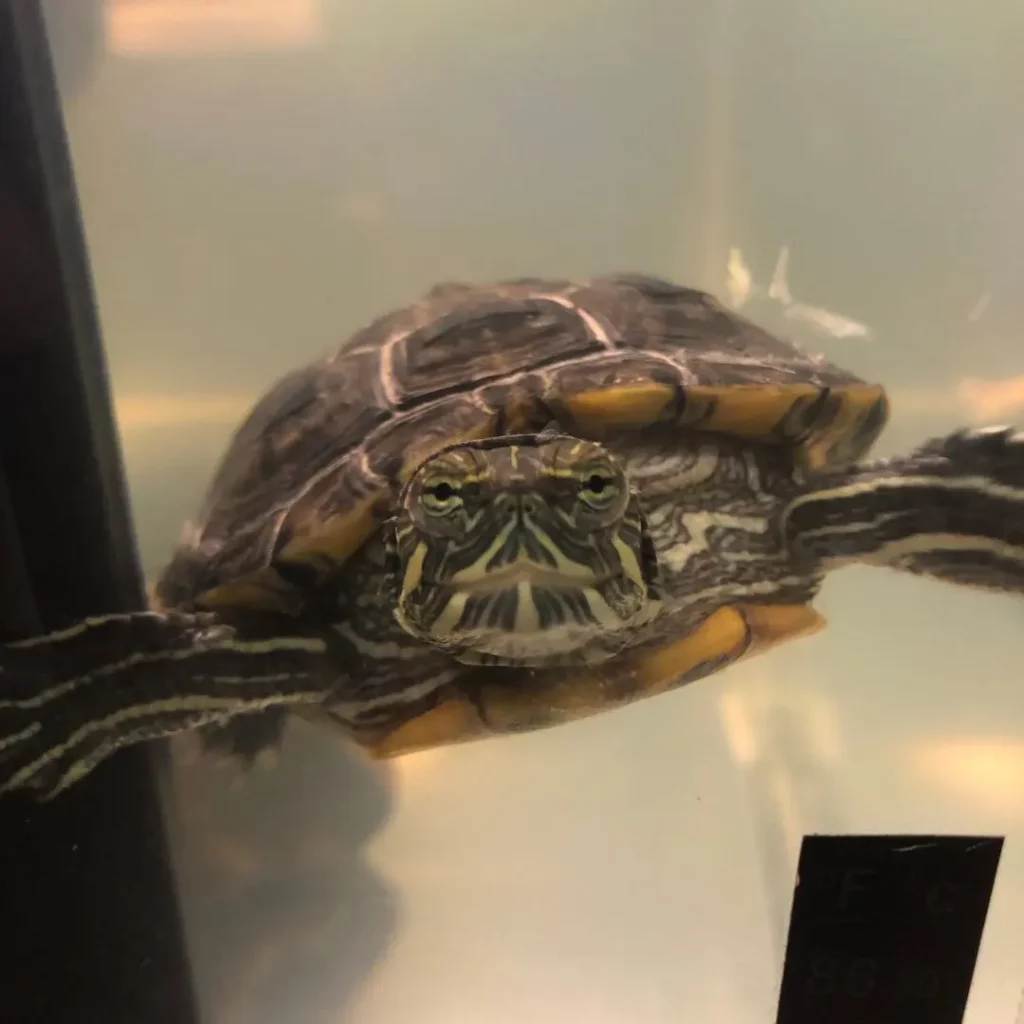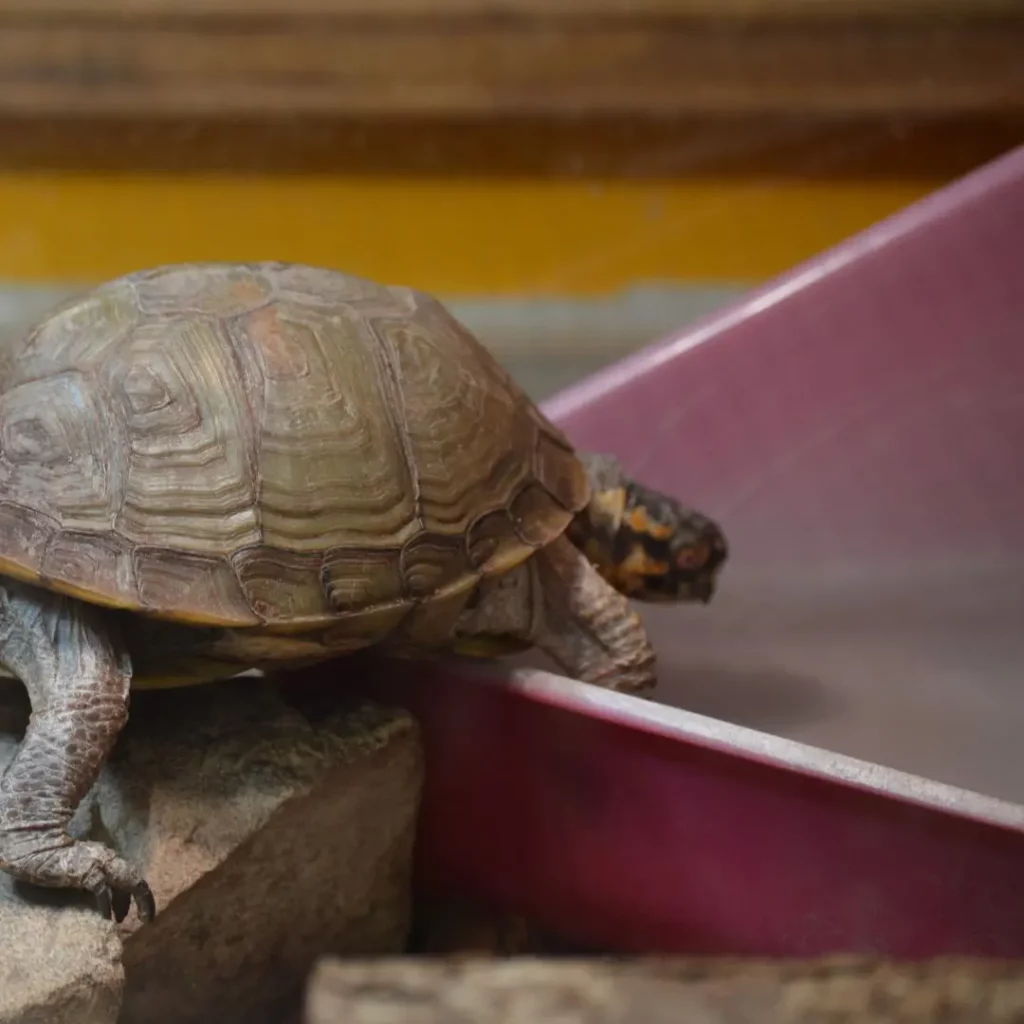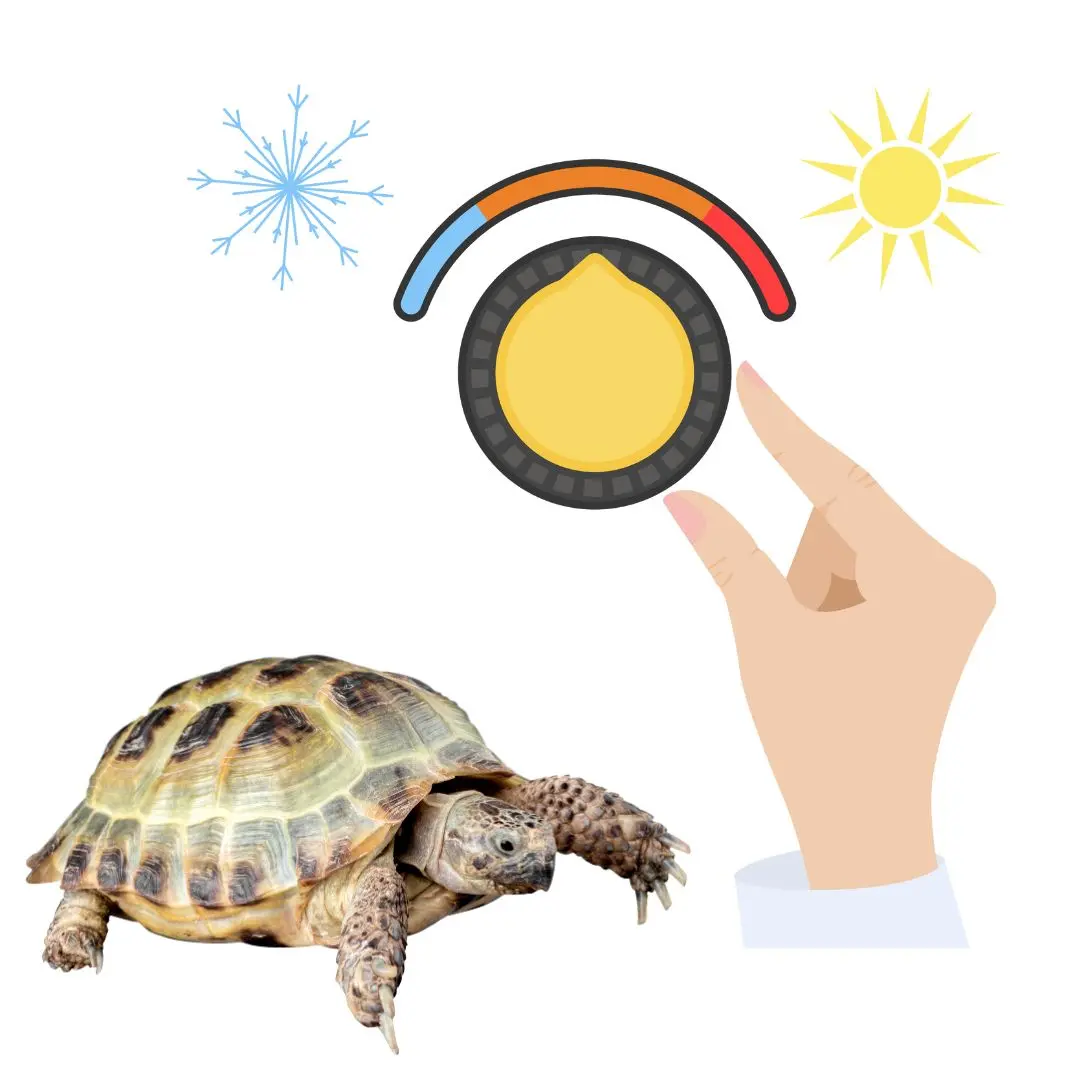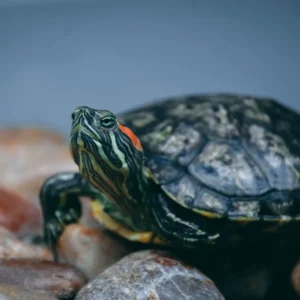Temperature plays one of the most vital roles when it comes to the well-being of your turtle. If you have an aquatic turtle or any other turtle that lives in a water tank, it’s important to consider both water temperature and basking area temperature.
In this article, I’ll explain:
- what temperatures are best,
- three important factors to consider,
- how to adjust the temperature if your turtle gets sick,
- and answer some common questions new turtle parents often ask.
Reaching the right temperature can be a bit tricky. But don’t worry – I got you covered.
Let’s dive in.
Table of Contents
What Is the Right Temperature for Turtle Tank?
In general, the average temperature for a turtle tank should be from 70°F to 80°F/21.1°C to 26.7°C. Providing the right temperature for their habitat will greatly impact their well-being and how long turtles live. But keep in mind that the temperature you should choose for your turtle’s tank varies based on multiple factors.
For example, the turtle tank temperature should depend on:
- Turtle’s species: Some species are simply used to different temperatures, based on their natural habitats/origins.
- Age of the turtle: Baby turtles can grow incredibly fast and they require an active metabolism to digest their food efficiently.
Since the ideal temperature significantly helps in their metabolism processes, the temperature a baby turtle needs differs from a fully-grown turtle. More precisely, baby turtles will need a tank temperature about 5°F/2°C higher than adults.
On the other hand, older/senior turtles can thrive in slightly lower temperatures.
- Whether the turtle is sick or not: Similar to us, a warm enough environment will help in their recovery if they get sick. Generally, you should increase the temperature in your turtle’s tank for about 4°F/2°C when they’re sick.
To help you find the right temperature for your turtle’s tank, I listed the best temperature values for the most popular types of the pet turtles, based on these factors.
| Temperatures for Adult Turtles | |
| Turtle | Temperature |
| Red-Eared Slider | 82°F – 86°F / 27.8°C – 30°C |
| Yellow-Bellied Slider | 85°F – 90°F / 29.4°C – 32.2°C |
| Diamond-back Terrapin | 85°F – 92°F / 29.4°C – 33.3°C |
| Mississippi Map | 80°F – 85°F / 26.7°C – 29.4°C |
| Box turtles | |
| Painted turtles | 85°F – 90°F / 29.4°C – 32.2°C |
| Spotted turtles | 85°F – 90°F / 29.4°C – 32.2°C |
| Temperatures for Baby Turtles | |
| Turtle | Temperature |
| Red-Eared Slider | 87°F – 91°F / 30.5°C – 32.8°C |
| Yellow-Bellied Slider | 90°F – 95°F / 32.2°C – 35°C |
| Diamond-back Terrapin | 90°F – 97°F / 32.2°C – 36.1°C |
| Mississippi Map | 85°F – 90°F / 29.4°C – 30°C |
| Box turtles | |
| Painted turtles | 90°F – 95°F / 32.2°C – 35°C |
| Spotted turtles | 90°F – 95°F / 32.2°C – 35°C |
How to Establish the Right Temperature In a Turtle Tank?

To establish the right temperature in your turtle’s tank, you’ll need to set up two different temperatures first. These include:
- Water temperature
- Basking area temperature
Achieving the Right Water Temperature
The most accurate and reliable way to establish the right temperature of water in your turtle tank is to use a water heater.
Water heaters are excellent because they allow you to change the temperature inside of the tank, where turtles spend the most time in general.
However, not any water heater will do – there are important features to consider so you need to find the one that ticks all the boxes.
Here are the most important features you should consider when choosing the right water heater:
- Heat guard: Your turtle’s safety is a top priority. Look for a heater with a heat guard to prevent any accidental burns.
- Sturdiness: Turtles have a knack for breaking things, so you’ll need a heater that can withstand their curious nature. Opt for a sturdy one that’s durable enough that won’t easily break.
- Adjustable temperature: Not every turtle is the same, each one has their personal preference when it comes to living conditions. While it’s fine to maintain the recommended temperature, the best way to adjust the water temperature is by considering your turtle’s preferences.
So be sure to choose a heater that allows you to adjust the temperature according to your turtle’s needs.
- Sufficient power: Turtles need spacious tanks and not all water heaters are up to the task of heating all that space. That’s why you should look for a heater with enough power to effectively warm up the water in a tank, especially for large one.
Here are some quality water heaters I’d recommend:
- Tetra 26445 Fauna Aquatic Reptile Heater
- Zoo Med TURTLETHERM Automatic Preset Aquatic Turtle Heater
- Orlushy Submersible Aquarium Heater
Achieving the Right Basking Area Temperature
A Basking area is an additional space between water and a light source, allowing turtles to engage in basking. So, to establish the right temperature in your turtle’s tank, you shouldn’t forget about the basking area.
The best way to do this is to use a heat bulb. But keep in mind that there are some important guidelines to follow when choosing and placing a heat bulb above the basking platform.
| 50W | 75W | 100W | 150W | ||||
| Distance | Temperature | Distance | Temperature | Distance | Temperature | Distance | Temperature |
| 4 inches/10.2 cm | 104°F/40°C | 4 inches/10.2 cm | 120°F/48.9°C | 4 inches/10.2 cm | 131°F/55°C | 4 inches/10.2 cm | 144°F/62.2°C |
| 8 inches/20.3 cm | 81°F/27.2°C | 8 inches/20.3 cm | 91°F/32.8°C | 8 inches/20.3 cm | 113°F/45°C | 8 inches/20.3 cm | 131°F/55°C |
| 12 inches/30.5 cm | 73°F/22.8°C | 12 inches/30.5 cm | 81°F/27.2°C | 12 inches/30.5 cm | 90°F/32.2°C | 12 inches/30.5 cm | 126°F/52.2°C |
Pro tip: The best choice is to opt for an UVB lighting, as this type of light not only acts as a heating system for the basking platform, but also significantly improves Vitamin D3 synthesis in your turtle – a process beneficial for calcium absorption in turtles.
If you’re not sure which heat bulb to buy for your shelled companion, here are a few ideas:
- Jaenmsa 4-Pack 50W UVA UVB Bulbs
- CALPALMY 4-Pack 75W UVA+UVB Bulbs
- MIXJOY 100W Reptile Heat Lamp Bulb
- Reptile Heat Lamps by DallFoll Store
How to Maintain the Ideal Temperature In a Turtle Tank?
Now that you know how to find the right temperature for your turtle’s tank, you may wonder how to constantly keep the same temperature.
Here are some important tips to help you maintain the ideal temperature:
- Use thermometers to monitor temperatures in all areas. Don’t have any thermometers yet? No worries – here are some quality ones to check out:
- VIVOSUN 1-Pack LCD Digital Aquarium Thermometer
- 2-Pack Aquarium Thermometer by AikTryee
- Veanic 4-Pack Digital Thermometer
Pro tip: Try positioning one thermometer in the cooler section (under water) of the tank and another in the basking spot.
- Use heating bulbs.
- Provide barriers around heaters to prevent your turtles from breaking it down, or even worse, getting burned/hurt.
- Consult a veterinarian who’s a herpetologist if you have questions about proper temperature guidelines.
Adjusting the Temperature for a Sick Turtle

While increasing the temperature can sometimes be helpful for sick turtles, it’s important to approach it cautiously and with specific details in mind.
Here’s what you need to know:
- Consult a veterinarian: Before making any temperature adjustments, always consult a vet. They can diagnose the underlying cause of your turtle’s illness and recommend the most appropriate treatment plan, which may or may not involve temperature changes.
- Small, gradual increases: If your vet recommends increasing the temperature, start with a small bump of 2-5°F (1-3°C) in the basking area only. Monitor your turtle closely for any negative reactions like increased lethargy or stress.
Remember: to never change the temperatures in your turtle’s tank drastically and suddenly.
- Don’t forget about basking area temperature: Aim for a basking temperature specific to your turtle species.
- Monitor closely: Pay close attention to your turtle’s behavior and adjust the temperature accordingly. If they seem stressed or lethargic, reduce the temperature immediately.
Note: Increasing temperature is just one potential, supportive measure for a sick turtle. Always prioritize consulting a veterinarian for proper diagnosis and treatment.
Vet Q&A
How cold is too cold for a turtle?
If the temperature in your turtle’s tank is lower than 50˚F (10˚C), the environment becomes too cold for them. In this case, your turtle is at risk of getting sick, potentially leading to death if the temperature doesn’t increase.
However, this rarely happens because of our well-balanced room temperature and mostly applies to turtles who live outdoors.
Is 90 degrees too hot for a turtle?
There’s no specific answer because all turtles like being in a warm habitat and some species like Diamond-back Terrapin and Painted turtles enjoy this range of temperature.
Also, baby and juvenile turtles often thrive in slightly higher temperatures than this – they need higher temperatures for the benefit of active metabolism, in order to keep growing.
Should I turn off my turtles heat lamp at night?
The simple answer is yes. Although leaving it on won’t necessarily harm your turtle, turning it off will provide them with exposure to dark. This is important for them because turtles are used to both light and dark in their natural habitats.
My Senior Paws is a participant in the Amazon Services LLC Associates Program, an affiliate advertising program designed to provide a means for sites to earn advertising fees by advertising and linking to Amazon.com. We also participate in other affiliate programs which compensate us for referring traffic.




